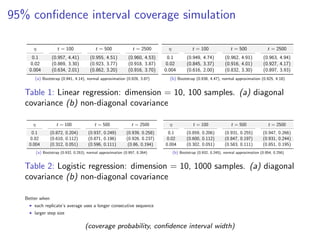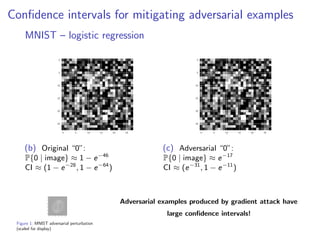The document discusses the use of stochastic gradient descent (SGD) in statistical inference, particularly in computing confidence intervals that can detect adversarial attacks. It presents a method for efficiently calculating these intervals using SGD, which is not only computationally efficient but integrates well with existing neural network training frameworks. The work also references theoretical guarantees and empirical simulations supporting the effectiveness of SGD in estimating uncertainty in the presence of adversarial examples.
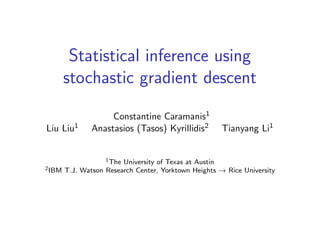

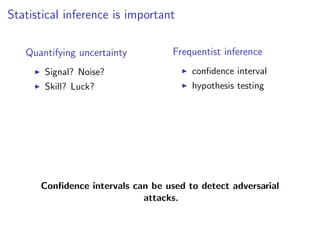

![SGD in ERM – mini batch SGD
To solve empirical risk minimization (ERM)
f (θ) =
1
n
n
i=1
fi (θ),
where fi (θ) = θ(Zi ).
At each step:
Draw S i.i.d. uniformly random indices It from [n] (with
replacement)
Compute stochastic gradient gs(θt) = 1
S i∈It
fi (θt)
θt+1 = θt − ηgs(θt)](https://image.slidesharecdn.com/04constantineapril18-180626032528/85/Statistical-Inference-Using-Stochastic-Gradient-Descent-5-320.jpg)
![Asymptotic normality – classical results
M-estimator – statistics
When number of samples n → ∞,
√
n(θ − θ∗
) N(0, H∗−1
G∗
H∗−1
),
where G∗ = EZ [ θ θ∗ (Z) θ θ∗ (Z) ] and H∗ = EZ [ 2
θ θ∗ (Z)].
Stochastic approximation – optimization
When number of steps t → ∞,
√
t
1
t
t
i=1
θt − θ N(0, H−1
GH−1
),
where G = E[gs(θ)gs(θ) |= θ] and H = 2f (θ).](https://image.slidesharecdn.com/04constantineapril18-180626032528/85/Statistical-Inference-Using-Stochastic-Gradient-Descent-6-320.jpg)
![Asymptotic normality – classical results
M-estimator – statistics
When number of samples n → ∞,
√
n(θ − θ∗
) N(0, H∗−1
G∗
H∗−1
),
where G∗ = EZ [ θ θ∗ (Z) θ θ∗ (Z) ] and H∗ = EZ [ 2
θ θ∗ (Z)].
Stochastic approximation – optimization
When number of steps t → ∞,
√
t
1
t
t
i=1
θt − θ N(0, H−1
GH−1
),
where G = E[gs(θ)gs(θ) |= θ] and H = 2f (θ).
SGD not only useful for optimization,
but also useful for statistical inference!](https://image.slidesharecdn.com/04constantineapril18-180626032528/85/Statistical-Inference-Using-Stochastic-Gradient-Descent-7-320.jpg)
![Statistical inference using mini batch SGD
burn in
θ−b, θ−b+1, · · · θ−1, θ0,
¯θ
(i)
t =1
t
t
j=1 θ
(i)
j
θ
(1)
1 , θ
(1)
2 , · · · , θ
(1)
t
discarded
θ
(1)
t+1, θ
(1)
t+2, · · · , θ
(1)
t+d
θ
(2)
1 , θ
(2)
2 , · · · , θ
(2)
t θ
(2)
t+1, θ
(2)
t+2, · · · , θ
(2)
t+d
...
θ
(R)
1 , θ
(R)
2 , · · · , θ
(R)
t θ
(R)
t+1, θ
(R)
t+2, · · · , θ
(R)
t+d
At each step:
Draw S i.i.d. uniformly random
indices It from [n] (with replacement)
Compute stochastic gradient
gs(θt) = 1
S i∈It
fi (θt)
θt+1 = θt − ηgs(θt)
Use an ensemble of i = 1, 2, . . . , R estima-
tors for statistical inference:
θ(i)
= θ +
√
S
√
t
√
n
(¯θ
(i)
t − θ).](https://image.slidesharecdn.com/04constantineapril18-180626032528/85/Statistical-Inference-Using-Stochastic-Gradient-Descent-8-320.jpg)



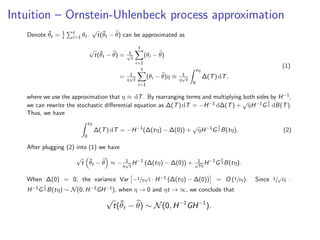
![Theoretical guarantee
Theorem
For a differentiable convex function f (θ) = 1
n
n
i=1 fi (θ), with gradient f (θ), let θ ∈ Rp be
its minimizer, and denote its Hessian at θ by H := 2f (θ) . Assume that ∀θ ∈ Rp, f satisfies:
(F1) Weak strong convexity: (θ − θ) f (θ) ≥ α θ − θ 2
2, for constant α > 0,
(F2) Lipschitz gradient continuity: f (θ) 2 ≤ L θ − θ 2, for constant L > 0,
(F3) Bounded Taylor remainder: f (θ) − H(θ − θ) 2 ≤ E θ − θ 2
2, for constant E > 0,
(F4) Bounded Hessian spectrum at θ: 0 < λL ≤ λi (H) ≤ λU < ∞, ∀i.
Furthermore, let gs(θ) be a stochastic gradient of f , satisfying:
(G1) E [gs(θ) | θ] = f (θ),
(G2) E gs(θ) 2
2 | θ ≤ A θ − θ 2
2 + B,
(G3) E gs(θ) 4
2 | θ ≤ C θ − θ 4
2 + D,
(G4) E gs(θ)gs(θ) | θ − G 2
≤ A1 θ − θ 2 + A2 θ − θ 2
2 + A3 θ − θ 3
2 + A4 θ − θ 4
2,
for positive, data dependent constants A, B, C, D, Ai , for i = 1, . . . , 4. Assume that
θ1 − θ 2
2 = O(η); then for sufficiently small step size η > 0, the average SGD sequence
θt = 1
t
n
i=1 θi satisfies:
tE[(¯θt − θ)(¯θt − θ) ] − H−1
GH−1
2
√
η + 1
tη + tη2,
where G = E[gs(θ)gs(θ) | θ].](https://image.slidesharecdn.com/04constantineapril18-180626032528/85/Statistical-Inference-Using-Stochastic-Gradient-Descent-13-320.jpg)
![Theoretical guarantee
Theorem
For a differentiable convex function f (θ) = 1
n
n
i=1 fi (θ), with gradient f (θ), let θ ∈ Rp be
its minimizer, and denote its Hessian at θ by H := 2f (θ) . Assume that ∀θ ∈ Rp, f satisfies:
(F1) Weak strong convexity: (θ − θ) f (θ) ≥ α θ − θ 2
2, for constant α > 0,
(F2) Lipschitz gradient continuity: f (θ) 2 ≤ L θ − θ 2, for constant L > 0,
(F3) Bounded Taylor remainder: f (θ) − H(θ − θ) 2 ≤ E θ − θ 2
2, for constant E > 0,
(F4) Bounded Hessian spectrum at θ: 0 < λL ≤ λi (H) ≤ λU < ∞, ∀i.
Furthermore, let gs(θ) be a stochastic gradient of f , satisfying:
(G1) E [gs(θ) | θ] = f (θ),
(G2) E gs(θ) 2
2 | θ ≤ A θ − θ 2
2 + B,
(G3) E gs(θ) 4
2 | θ ≤ C θ − θ 4
2 + D,
(G4) E gs(θ)gs(θ) | θ − G 2
≤ A1 θ − θ 2 + A2 θ − θ 2
2 + A3 θ − θ 3
2 + A4 θ − θ 4
2,
for positive, data dependent constants A, B, C, D, Ai , for i = 1, . . . , 4. Assume that
θ1 − θ 2
2 = O(η); then for sufficiently small step size η > 0, the average SGD sequence
θt = 1
t
n
i=1 θi satisfies:
tE[(¯θt − θ)(¯θt − θ) ] − H−1
GH−1
2
√
η + 1
tη + tη2,
where G = E[gs(θ)gs(θ) | θ].
Proof idea: H−1 = η i≥0(I − ηH)i](https://image.slidesharecdn.com/04constantineapril18-180626032528/85/Statistical-Inference-Using-Stochastic-Gradient-Descent-14-320.jpg)

